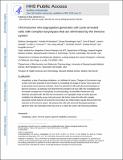| dc.contributor.author | Richardson, Amelia | |
| dc.contributor.author | Iyer, Divya Ramalingam | |
| dc.contributor.author | Wong, Yao Liang | |
| dc.contributor.author | Rhind, Nicholas | |
| dc.contributor.author | Desai, Arshad | |
| dc.contributor.author | Santaguida, Stefano | |
| dc.contributor.author | M'Saad, Ons | |
| dc.contributor.author | Zasadil, Lauren M | |
| dc.contributor.author | Knouse, Kristin Ann | |
| dc.contributor.author | Amon, Angelika B | |
| dc.date.accessioned | 2018-06-25T14:11:51Z | |
| dc.date.available | 2018-06-25T14:11:51Z | |
| dc.date.issued | 2017-06 | |
| dc.date.submitted | 2017-03 | |
| dc.identifier.issn | 1534-5807 | |
| dc.identifier.issn | 1878-1551 | |
| dc.identifier.uri | http://hdl.handle.net/1721.1/116548 | |
| dc.description.abstract | Aneuploidy, a state of karyotype imbalance, is a hallmark of cancer. Changes in chromosome copy number have been proposed to drive disease by modulating the dosage of cancer driver genes and by promoting cancer genome evolution. Given the potential of cells with abnormal karyotypes to become cancerous, do pathways that limit the prevalence of such cells exist? By investigating the immediate consequences of aneuploidy on cell physiology, we identified mechanisms that eliminate aneuploid cells. We find that chromosome mis-segregation leads to further genomic instability that ultimately causes cell-cycle arrest. We further show that cells with complex karyotypes exhibit features of senescence and produce pro-inflammatory signals that promote their clearance by the immune system. We propose that cells with abnormal karyotypes generate a signal for their own elimination that may serve as a means for cancer cell immunosurveillance. By examining the immediate consequences of chromosome mis-segregation, Santaguida et al. show that aneuploidy causes genomic instability and the evolution of cells with complex karyotypes. Such cells undergo senescence and produce pro-inflammatory cytokines that promote their clearance by natural killer cells. Keywords: aneuploidy; cancer; immune system; genome instability; senescence | en_US |
| dc.description.sponsorship | National Institutes of Health (U.S.) (Grant CA206157) | en_US |
| dc.description.sponsorship | National Institutes of Health (U.S.) (Grant GM118066) | en_US |
| dc.description.sponsorship | National Institute of General Medical Sciences (U.S.) (Grant T32GM007753) | en_US |
| dc.publisher | Elsevier BV | en_US |
| dc.relation.isversionof | http://dx.doi.org/10.1016/J.DEVCEL.2017.05.022 | en_US |
| dc.rights | Creative Commons Attribution-NonCommercial-NoDerivs License | en_US |
| dc.rights.uri | http://creativecommons.org/licenses/by-nc-nd/4.0/ | en_US |
| dc.source | PMC | en_US |
| dc.title | Chromosome Mis-segregation Generates Cell-Cycle-Arrested Cells with Complex Karyotypes that Are Eliminated by the Immune System | en_US |
| dc.type | Article | en_US |
| dc.identifier.citation | Santaguida, Stefano et al. “Chromosome Mis-Segregation Generates Cell-Cycle-Arrested Cells with Complex Karyotypes That Are Eliminated by the Immune System.” Developmental Cell 41, 6 (June 2017): 638–651 © 2017 Elsevier Inc | en_US |
| dc.contributor.department | Massachusetts Institute of Technology. Department of Biology | en_US |
| dc.contributor.department | Koch Institute for Integrative Cancer Research at MIT | en_US |
| dc.contributor.mitauthor | Santaguida, Stefano | |
| dc.contributor.mitauthor | M'Saad, Ons | |
| dc.contributor.mitauthor | Zasadil, Lauren M | |
| dc.contributor.mitauthor | Knouse, Kristin Ann | |
| dc.contributor.mitauthor | Amon, Angelika B | |
| dc.relation.journal | Developmental Cell | en_US |
| dc.eprint.version | Author's final manuscript | en_US |
| dc.type.uri | http://purl.org/eprint/type/JournalArticle | en_US |
| eprint.status | http://purl.org/eprint/status/PeerReviewed | en_US |
| dc.date.updated | 2018-06-22T17:20:44Z | |
| dspace.orderedauthors | Santaguida, Stefano; Richardson, Amelia; Iyer, Divya Ramalingam; M'Saad, Ons; Zasadil, Lauren; Knouse, Kristin A.; Wong, Yao Liang; Rhind, Nicholas; Desai, Arshad; Amon, Angelika | en_US |
| dspace.embargo.terms | N | en_US |
| dc.identifier.orcid | https://orcid.org/0000-0002-1501-6190 | |
| dc.identifier.orcid | https://orcid.org/0000-0003-0649-7428 | |
| dc.identifier.orcid | https://orcid.org/0000-0001-9837-0314 | |
| mit.license | PUBLISHER_CC | en_US |
